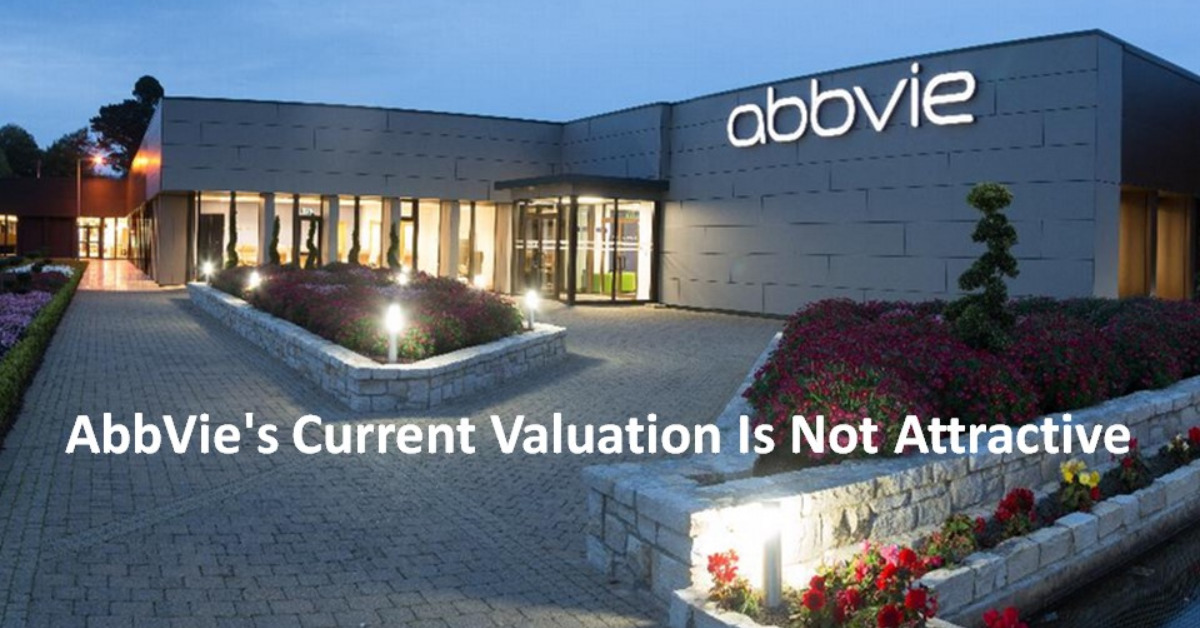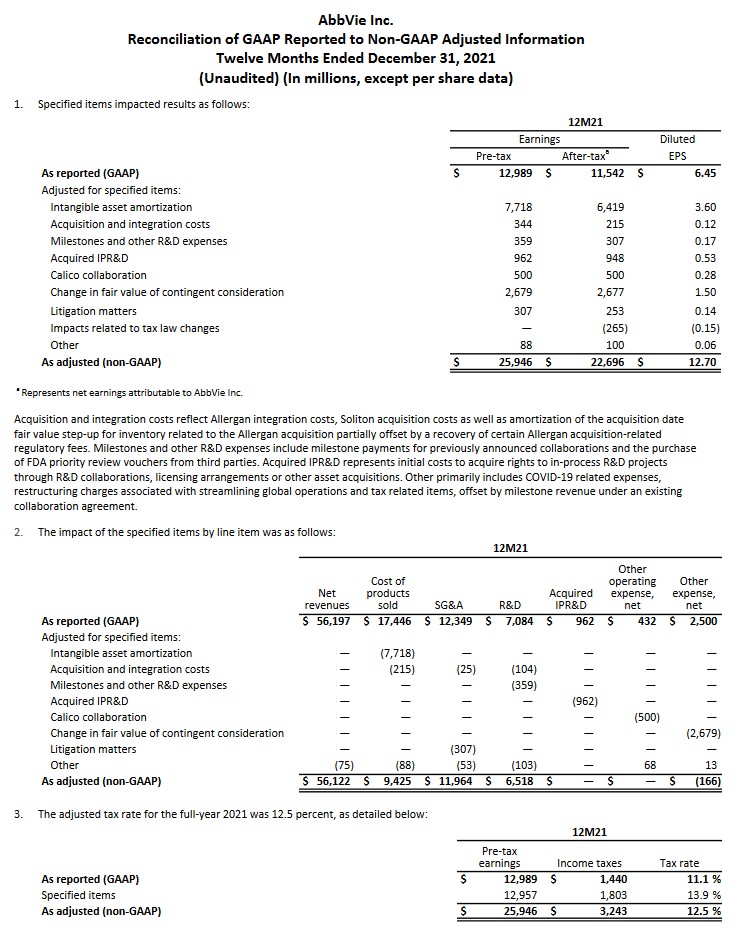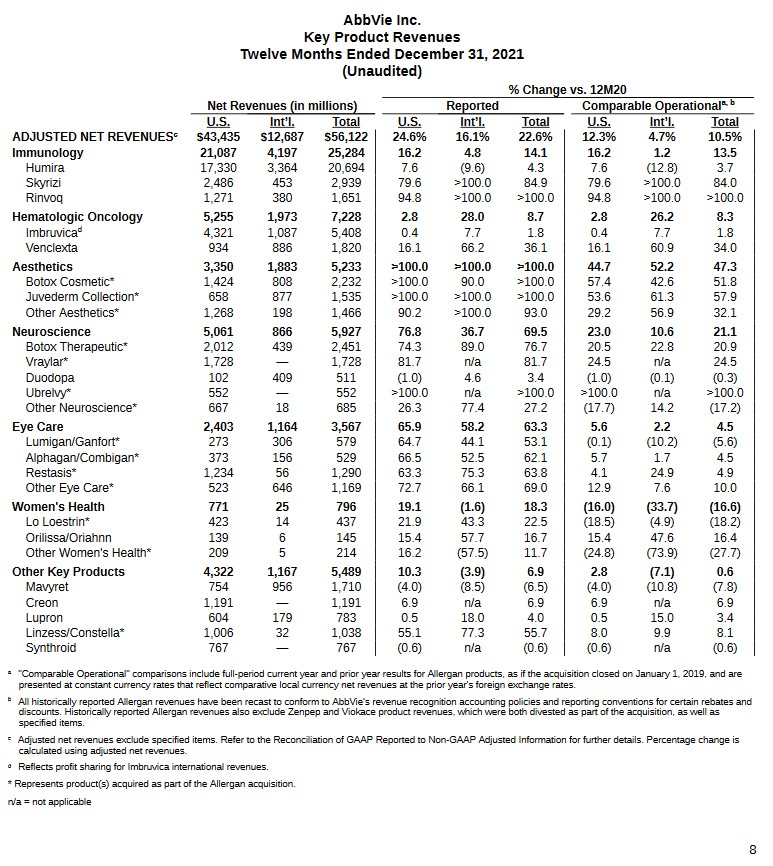Contents

In my October 31, 2021 post, I disclosed a new 200 share Abbvie Inc. (ABBV) position; I acquired shares @ $108.70/share on October 22, 2021 in one of the ‘Core’ accounts in the FFJ Portfolio.
ABBV subsequently released Q3 and YTD2021 results on October 29 by which time its share price had run up to ~$114.70.
Fast forward to February 2, 2022 and shares are trading at ~$138.60. Based on FY2022 guidance, Abbvie’s current valuation is not attractive.
Pipeline
I reference my prior post in which I touch upon ABBV’s pipeline and significant programs and developments. In that post, I mention the risk of investing in ABBV is that ~37% of FY2021 Total Revenue was generated from Humira (one of ABBV’s immunology products); other biosimilars will very likely launch against it in 2023.
On February 2, 2022, ABBV provided a Pipeline Update.
Skyrizi and Rinvoq, reviewed in my previous post, are the drugs currently awaiting FDA approval.
Financials
Q4 and FY2021 Results
The February 2, 2022 Earnings Release reflects ABBV’s Q4 and FY2021 results and FY2022 guidance.
The following reconciliation discloses the various adjustments made to arrive at non-GAAP earnings. We can expect ongoing sizable intangible asset amortization adjustments as this relates to the $63B Allergan plc acquisition; this is a non-cash charge.

Source: ABBV – Q4 and FY2021 Earnings Release – February 2, 2022
Outlook
ABBV’s FY2022 GAAP diluted EPS guidance is $9.26 – $9.46 and FY2022 Adjusted diluted EPS guidance is $14.00 – $14.20.
Approximately $2B of this FCF is allocated annually to augment the pipeline with the most promising external technologies and innovative therapies.
ABBV’s strong performance continues to support capital allocation priorities. Management expects to generate an adjusted free cash flow (FCF) of ~$24B in FY2022. This is net of ~$1B in Skyrizi royalty payments.
Just over $12B of this FCF is to be applied toward debt reduction in FY2022; management is forecasting a net leverage ratio of 1.8 times by the end of the year.
Long-Term Debt
Details of ABBV’s long-term debt are found on page 72 of 155 in the FY2020 10-K. At FYE2020, ABBV had ~$86B of total long-term debt and finance lease obligations with the current portion being ~$8.5B and the non-current portion being ~$77.6B.
At the end of Q3 2021 (Q3 Form 10-Q), the current portion was ~$6.656B versus ~$7.9B at the end of Q2 2021 (Q2 Form10-Q). The long-term portion at the end of Q3 2021 was $74.049B versus ~$74.237B at the end of Q2 20221.
Credit Ratings
ABBV’s senior unsecured long-term debt remains unchanged from my prior review. The ratings are:
- Moody’s: Baa2 with a stable outlook
- S&P Global: BBB+ with a stable outlook
The rating assigned by S&P Global is the top tier of the lower-medium grade investment-grade category and is one tier above Moody’s.
Both ratings define ABBV as having an ADEQUATE capacity to meet its financial commitments. However, adverse economic conditions or changing circumstances are more likely to lead to a weakened capacity of the obligor to meet its financial commitments.
These investment-grade ratings are satisfactory for my purposes.
Dividend and Dividend Yield
ABBV’s dividend history is accessible here.
In my prior review, ABBV had just declared a ~8.5% increase in the quarterly cash dividend from $1.30/share to $1.41/share beginning with the dividend payable on February 15, 2022 to shareholders of record as of January 14, 2022.
Using my ~$108.70 purchase price, the forward dividend yield was ~5.2%. Shares are now trading at ~$138.60 and the forward dividend yield is ~4.1%.
It has increased its quarterly dividend by more than 250% since its inception in 2013.
On the Q4 earnings call. management reiterated its plans to grow the dividend.
While the dividend yield remains attractive despite the run-up in the share price, investors would be wise not to fixate on the dividend or dividend yield. It is preferable to look at a company’s total potential investment return (capital gains and dividend income).
The weighted-average diluted shares outstanding (in millions) in FY2013 – FY2021 is 1604, 1610, 1637, 1631, 1603, 1546, 1484, 1673 and 1777.
Despite the YTD repurchase, the weighted-average diluted shares outstanding has risen from 1673 in FY2020 to 1777 in FY2021.
ABBV – Stock Analysis – Valuation
FY2013 – FY2020 PE levels are 18.51, 28.45, 34.64, 16.92, 23.47, 19.13, 39.00, and 23.09. There is little point, however, in comparing ABBV’s current valuation with historical levels because the current version of ABBV is nothing like that before the May 8, 2020 Allergan plc acquisition.
At the time of my October 29, 2021 post, ABBV had generated YTD diluted EPS of $4.19 and FY2021 guidance was $6.29 – $6.33. Using the $6.31 mid-point and the ~$114.70 share price, the forward diluted PE was ~18.
The YTD adjusted diluted EPS at the time of my previous post was $9.39 and FY2021 guidance was $12.63 – $12.67. Using the $12.65 mid-point, the forward adjusted diluted PE was ~9.
The following forward adjusted diluted PE levels were derived from the broker guidance reflected on the two online trading platforms I use.
- FY2021 – 19 brokers – mean of $12.60 and low/high of $12.17 – $12.75. Using the mean estimate I get ~9.
- FY2022 – 17 brokers – mean of $13.92 and low/high of $12.87 – $14.70. Using the mean estimate I get ~8.2.
- FY2023 – 14 brokers – mean of $12.17 and low/high of $11.53 – $13.40. Using the mean estimate I get ~9.4.
ABBV has now reported $6.45 of Full-Year Diluted EPS on a GAAP basis (a 137.1% YoY increase) and $12.70 of Adjusted Diluted EPS, a 20.3% YoY increase). Its valuation based on historical results is even more favourable than when I wrote my previous post.
FY2022 GAAP diluted EPS guidance is $9.26 – $9.46 and FY2022 adjusted diluted EPS guidance is $14.00 – $14.20. Using the current ~$138.60 share price and the mid-point of guidance, the forward diluted PE is ~14.8 and the forward adjusted diluted PE is ~9.8.
The forward adjusted diluted PE levels below are based on the broker guidance derived from the two online trading platforms I use and the current ~$138.60 share price.
- FY2022 – 23 brokers – mean of $14.03 and low/high of $13.26 – $14.91. Using the mean estimate I get ~10.
- FY2023 – 20 brokers – mean of $12.11 and low/high of $11.27 – $13.30. Using the mean estimate I get ~11.5.
- FY2024 – 15 brokers – mean of $12.24 and low/high of $11.14 – $13.24. Using the mean estimate I get ~11.3.
ABBV – Stock Analysis – Final Thoughts
Any ABBV investment should be made knowing full well that ~37% of FY2021 Total Revenue was generated from Humira, a drug that loses exclusivity in 2023. This is a significant risk, and therefore, investors should look to acquire shares at a very low valuation.
I do not intend to acquire additional shares despite forward-adjusted diluted PE levels in the low teens. A valuation in the upper single digits seems more appropriate.
ABBV’s share price has risen ~27.5% subsequent to my October 22, 2021 purchase and given current market volatility, I would not be surprised to see a pullback in ABBV’s share price.
If ABBV generates $14.03 in FY2022 adjusted diluted EPS, the mean FY2022 guidance from brokers, and we use a PE multiple of 9, then a price below $127 seems more reasonable.
I wish you much success on your journey to financial freedom!
Note: Thanks for reading this article. Please send any feedback, corrections, or questions to finfreejourney@gmail.com.
Disclosure: I am long ABBV.
Disclaimer: I do not know your circumstances and am not providing individualized advice or recommendations. I encourage you not to make any investment decisions without conducting your research and due diligence. You should also consult your financial advisor about your specific situation.
I wrote this article myself and it expresses my own opinions. I am not receiving compensation for it and have no business relationship with any company whose stock is mentioned in this article.


